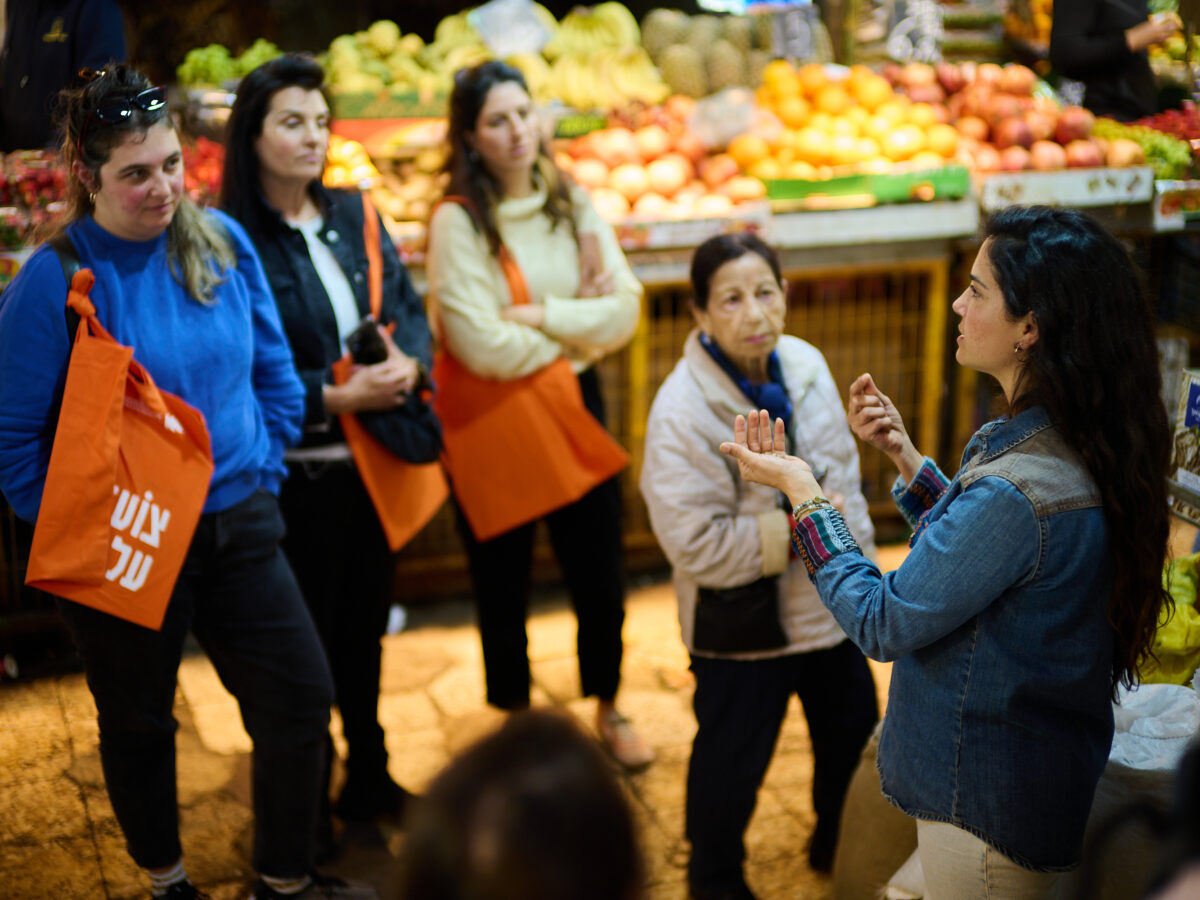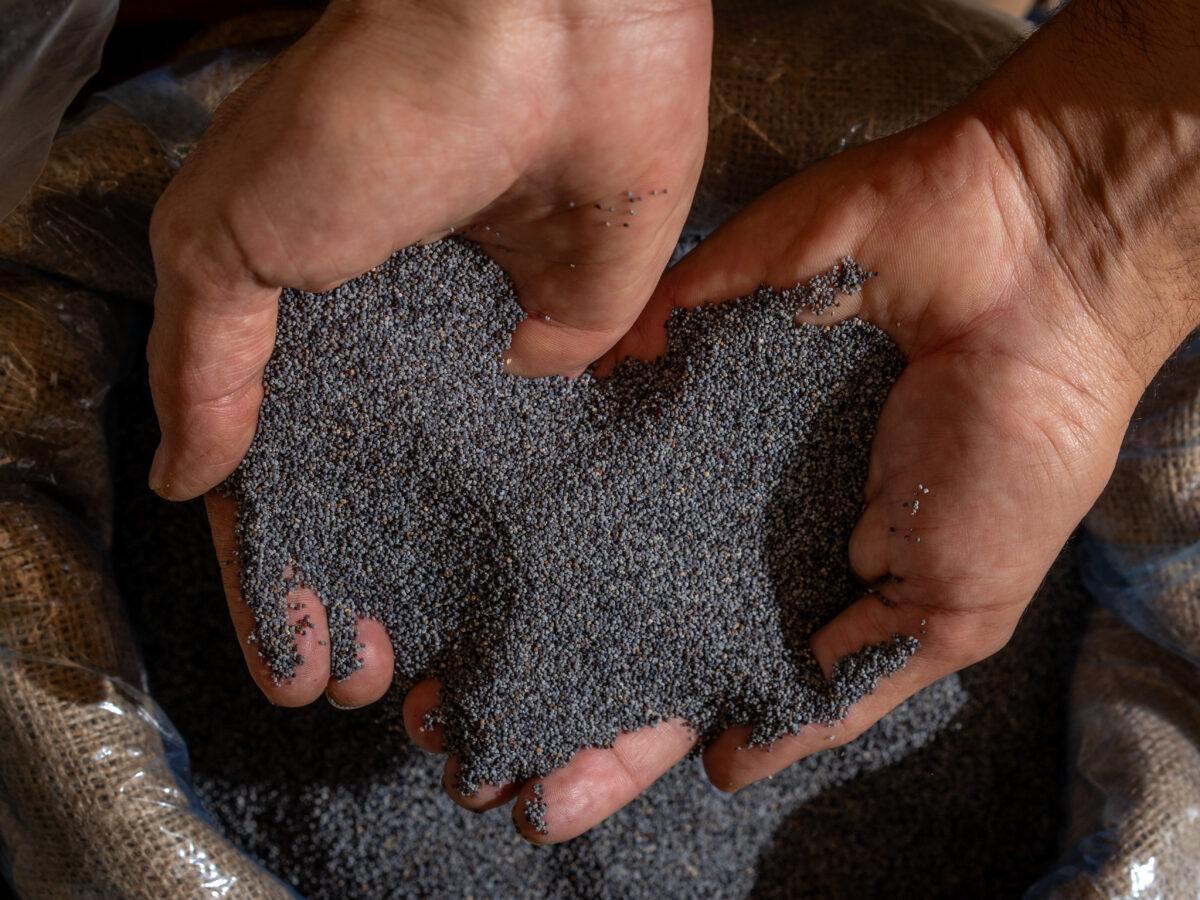Israeli food enthusiasts are always on the lookout for the latest culinary innovations — locally and abroad. Along with the search for new, trendy restaurants, bakeries, and provision shops, there’s a constant longing for those small, simple restaurants with affordable prices and retro magic, or “workers’ restaurants,” as we locals like to call them. We scour the country from north to south looking for the best hummus places, and travel to industrial areas in search of an unforgettable kubbeh soup, or an exquisitely-stuffed pita.
Over the last decade, a remarkable number of workers’ restaurants have opened in south Tel Aviv, offering generous portions of delicious home-made food at affordable prices. So why have so many Israelis missed the magic happening under their nose? There are several answers, but one key factor is the location of these restaurants — Tel Aviv’s Neve Sha’anan neighborhood.
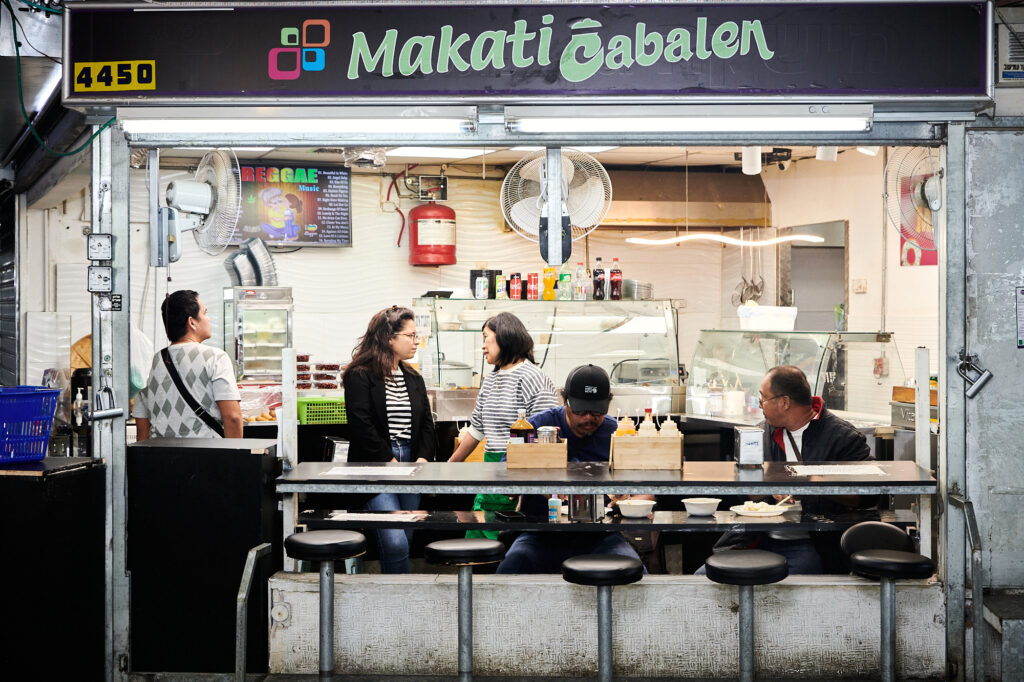
I grew up spending time in the neighborhood and have been working in it in different capacities since 2016, first through the World Food Market and later through Asian culinary tours, which I launched during COVID to help support businesses in the area.
A Story of a Neighborhood, or the Black Hole of Tel Aviv
Neve Sha’anan was founded in 1921 by Jews who fled Jaffa following the riots of the same year. It was a small, quiet neighborhood, home to about 400 Jews; yet this idyllic reality was short-lived. In 1941, the decision to build the first Central Bus Station in the neighborhood triggered a dramatic, rapid deterioration.
Within a few years, additional bus terminals were needed; they were built on adjacent streets in the residential neighborhood. Traffic and human congestion, the jumble of shops and stalls, and poor maintenance — all of these were fertile ground for crime, drugs, and prostitution, as well as growing numbers of unhoused people and those struggling with alcohol addiction. Residents began protesting the destruction of their home; those who could afford to, left.
The massive New Central Bus Station — proposed in the 1960s as a “solution” — was about to seal the neighborhood’s fate. The towering 40,000 square meter concrete structure opened in 1993 and residents were struck with a concrete monster that aggravated their problems instead of solving them. Moreover, 1,200 business owners discovered that the station’s complex structure hid them from potential customers. Most of them had to abandon their shops, a serious economic blow; some are still fighting for compensation.
Neve Sha’anan received the unwanted title: “the black hole of Tel Aviv.”
‘When Multiculturalism Is Sexier Abroad’
In October 2022 there were 133,648 migrant workers and 25,450 asylum seekers living in Israel. Although it may seem they have always been here, their story began rather late in Israel’s short history, with the First Intifada in 1987. In an attempt to replace Palestinian workers, thousands of migrants entered Israel with temporary permits, working mainly in construction, agriculture, and caretaking. By 2002, there were 250,000 migrant workers living within Israel, primarily concentrated in Neve Sha’anan and other neighborhoods in south Tel Aviv. Here expats can connect with their community, attend church, run errands, send money to their families, and get a taste of home.
In the years 2007-2012, about 30,000 asylum seekers, fleeing genocide and ethnic cleansing in Sudan and Eritrea, crossed Israel’s southern border. Buses loaded with overwhelmed, confused refugees, who had no legal status or employment prospects, headed to Neve Sha’anan. Sudanese and Eritrean men looking for temporary jobs crowded Levinsky Park in the neighborhood. Some, wishing to rebuild their lives both physically and mentally, opened small bars and workers’ restaurants; these, they hoped, could offer accessible, affordable, and nutritious food, as well as a shelter for those who had been torn away from their homes and families.
In Israeli society, the refugees and immigrants sadly came to be associated with all the bad sides of south Tel Aviv — crime, filth and neglect. The southern neighborhoods suffer from prejudice, racism, and a suspicion of foreigners. Multiculturalism for Israelis, sadly, is often sexier abroad; minorities and foreigners are most attractive when they are far away.
Yet culture and food always thrive where there is a multitude of communities and migrants. When we let go of our preconceptions, there is room for surprising discoveries, fascinating human encounters, and even those yearned-for culinary experiences.
Providing a Home Away from Home
Neve Sha’anan is home to Eritrean and Sudanese restaurants, one Nepali restaurant, a Chinese restaurant, and a few Filipino establishments. While there is a large community of Thai workers in agriculture, they largely live in the villages where they work across the country, cooking for themselves using products they grow or buy from specialized importers or at local grocery shops. Chinese construction workers have cooks who send food directly to their job sites.
Filipinos working as caregivers, on the other hand, usually return home exhausted after a long day of hard work, and have no time or energy to cook. Sometimes the employing family forbids them to cook at the patients’ home. For them, this new generation of workers’ restaurants provides food, company, and an experience reminiscent of the home they left behind. They come to have breakfast before work, or on their way back in the late afternoon or evening.
El Mano – Between Vietnam and the Philippines
One of the most charming stories of Neve Sha’anan, Filipino-Vietnamese restaurant El Mano, opened in 2019. The diverse menu includes Filipino dishes such as bulalo (a rich meat broth), sisig (crispy pork in a spicy sauce), seafood stews, and leche flan, a variation on the classic flan. It also offers Vietnamese classics like aromatic pho, refreshing summer rolls with plenty of herbs, and banh mi, the unrivaled Vietnamese baguette made with pork pâté.
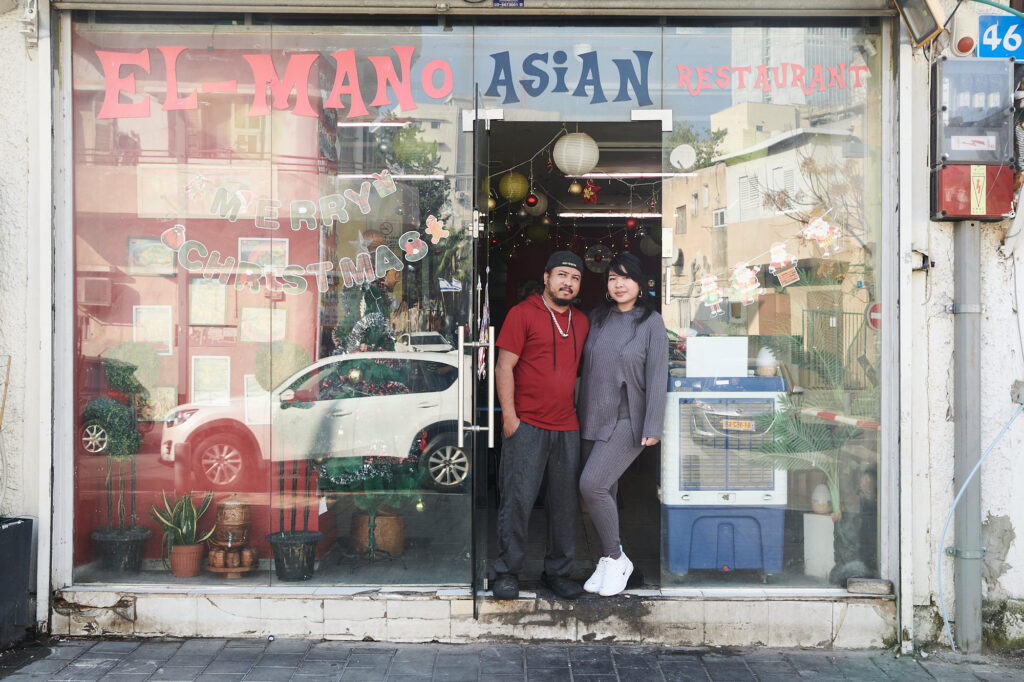
The owners are a couple: Ann Ho (32), whose parents arrived as refugees from the Vietnam War, and John Bautista (35), the son of Filipino migrant workers. “We met at the tzofim (Israeli scouts), when I was 13 years old,” says Anne. “I was in the Jaffa ‘tribe,’ where everyone was Israeli, and John was in south Tel Aviv, with many Filipino friends. They thought it was a strange sight, a sole foreigner with all these Israelis.”
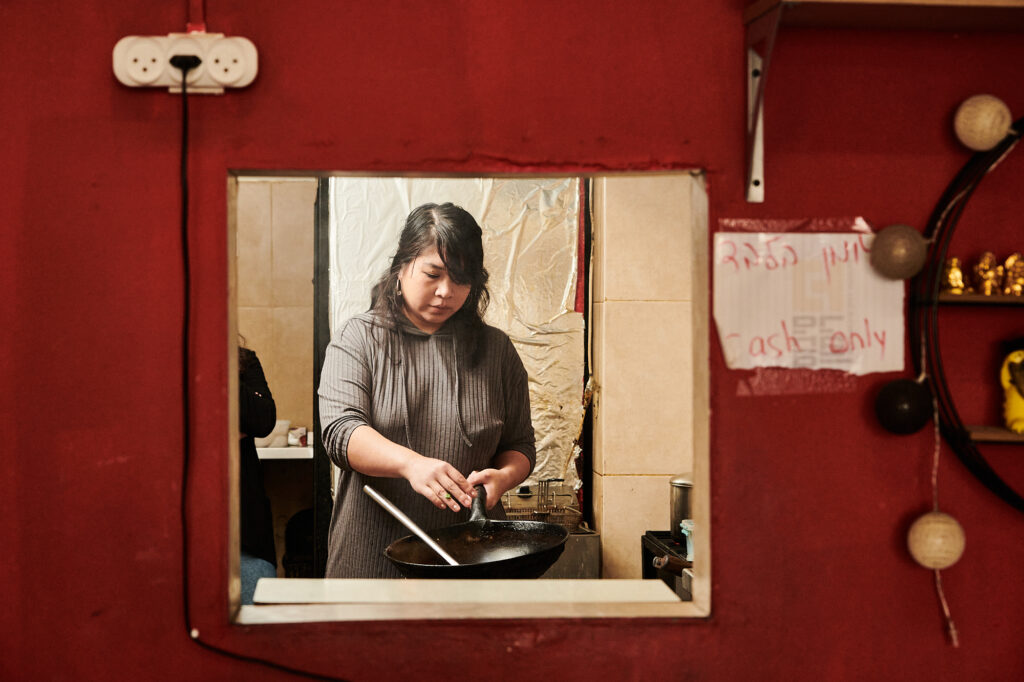
Anne was born and raised in Jaffa and began her culinary career at 15, working in restaurants such as The Red Chinese and Yona, both of which have since closed, and Manta Ray. “I dreamt of opening a restaurant of my own, with home-made food that would be very different from the restaurants I worked in,” she says. “I wanted people to eat the food I ate growing up, the things I had learned from my mother. There were no written recipes, we learned everything in the kitchen as we cooked.” Today, her restaurant opens in the afternoons and fills up with Filipino migrant workers.
How did El Mano start?
It all began when John’s mother found a location in Neve Sha’anan. John knows the area well, and most of the Filipinos in Israel live here, or come here to run errands and eat. In the beginning I tried to add a few Vietnamese dishes, but the Filipino customers, who make up most of our customers, did not approve. They come in the afternoon or evening after a long day of work to eat a proper meal. They are too tired to go shopping and cook for themselves.

What’s it been like operating El Mano?
It was and still is hard. We opened in 2019. We barely had time to get on our feet, and then the pandemic hit. Bills were piling up. We started selling packaged Filipino food. It drove me mad. The reason we opened in the first place was to serve tasty home-made food to be eaten on the spot, so that the lechon [lechon kawali, deep-fried pork belly slabs, crispy on the outside and soft on the inside] will be hot and crispy. At the same time, I got pregnant, and the doctor ordered me to stay in bed. Three months after giving birth I went back to work, having to reinvent myself.
At this stage, we went back to cooking at the restaurant, and I started adding some Vietnamese dishes. Then you came with your tours and some Israelis and bloggers, who order from both menus, started coming. But still, our core clientele is made up of Filipinos coming back from work hungry and exhausted, and looking for home-style food. Filipinos only like their own food, so they’re less interested in the Vietnamese dishes.
Now you already know how hard this business is. Where will you be five years from now?
Look, I was born in Jaffa. I have always been different; it wasn’t something you could ignore in my neighborhood. I had to develop a thick skin. I learned to be tough [Anne laughs]. But I want to stay in Neve Sha’anan. There’s something magical about this place, and we bring something that’s unique. Still, I would be happy for the restaurant to evolve and attract a wider clientele. I want El Mano to stay a simple restaurant serving home-made food, but to have Israeli customers too.
Will you continue to serve the Vietnamese dishes you grew up with?
I have always felt it was a shame that Vietnamese food did not make it in Israel because of its strong flavors; but then I saw how popular Thai food has become, without comprising or making adjustments to the Israeli palette. So why not Vietnamese food? Today, when Israelis come, I warn them in advance that it is going to be challenging. Usually they play along.

Makati Cabalen — “I’d Like One of These”
One of Neve Sha’anan’s most prominent establishments is a Filipino restaurant that has been operating inside the New Central Bus Station for almost a decade. Anabelle Marquez (57), the woman behind the stews and the warm smile accompanying the meal, makes up the daily menu according to her mood, using seasonal produce such as bitter melon, taro, pumpkin, and bamboo. There are always interesting things to try, like arroz caldo, a thick rice and chicken soup with plenty of ginger and garlic; pancit miki, or egg noodles with seafood; jackfruit stew with coconut cream; and the famous halo halo dessert made with crushed ice and lots of sweet toppings like dulce de leche and sweet purple yam. Like many of the other cooks in the workers’ restaurants of the area, Anabelle learned her cooking skills at home.
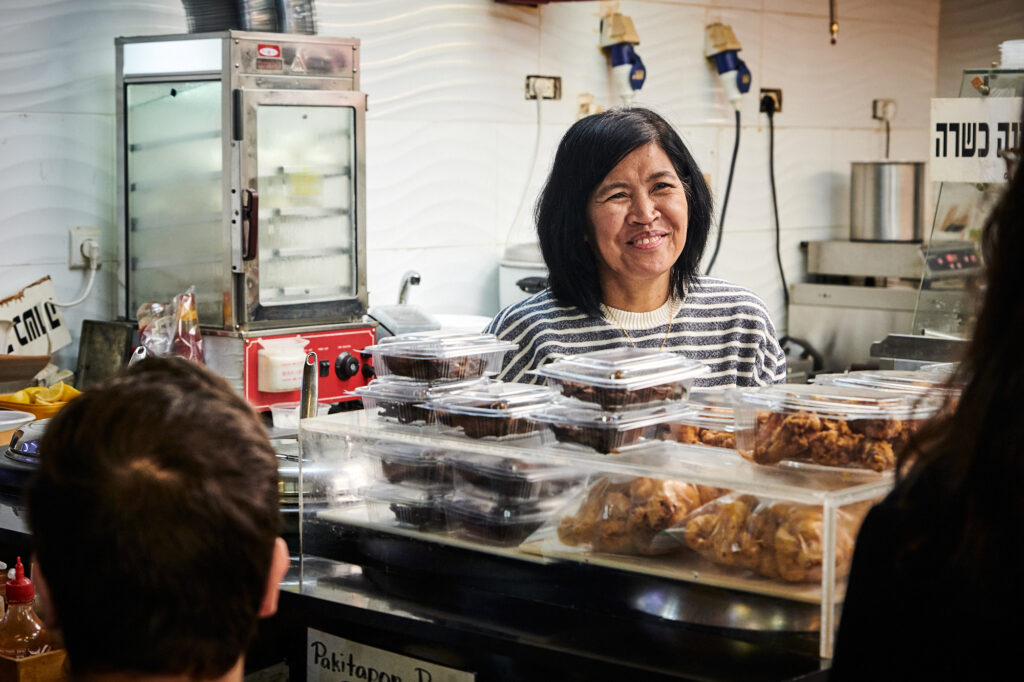
Leaving her 9-year-old daughter with her grandmother, she came to Israel to work as a caretaker to support her family. “I did that for 10 years, and then I met my Israeli partner,” she says. “I’ve been here for 20 years.”
How did the story of the Filipino restaurant at the central station begin?
In the beginning, it was just a supermarket with products from the Philippines, but the customers kept asking for prepared food: they were too tired to cook. We started with a food stand, selling food to take home. But the Filipinos kept coming with more requests, and so the stand grew and became a little restaurant. You must understand, many of the workers cannot cook at work — the employers don’t allow it. So they come in the morning before work, or after work, tired: they just want to eat and go to sleep. They say they feel at home here, the atmosphere is like at home. We have everything, so it helps with feeling less homesick. In the Philippines you call these restaurants a ‘turo turo,’ which means to point. You look at the food behind the glass and point at whatever you want.
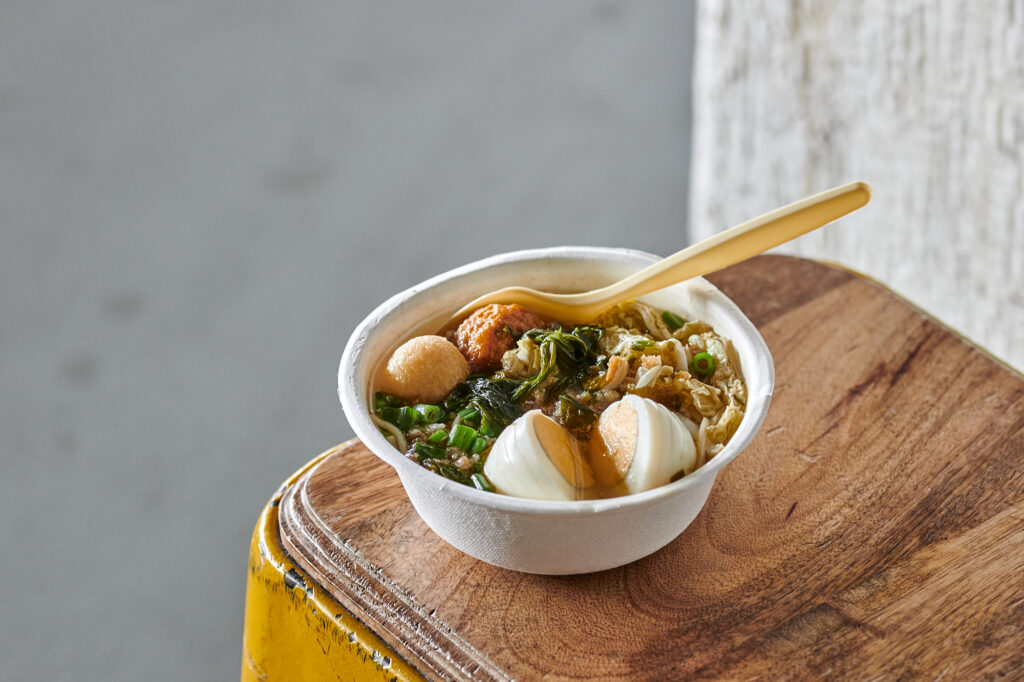
I work in the kitchen 7-8 hours a day, but I enjoy cooking; I don’t feel tired. I have a passion for sharing my food with others and know they enjoy it. I never received any professional training; I know the Filipino recipes and I make small changes according to my personal taste. When I arrived in Israel, many things were impossible to find. But then the Makati Cabalen supermarket opened. Eli Sharvit [the owner] started importing products, and then vegetables, from East Asia: cassava, saba banana, bitter melon, taro… so now we can make everything just like we did back home.”
Do Israelis also stop by for meals?
Most of the people who come to eat here are Filipino. There are some Israelis, and now more of them come because of you, because ‘Naama said dynamite eggroll [stuffed with hot peppers, beef and cheese] is tasty.’ It’s fun when Israelis come; it makes me happy that they want to try things, and if they like them, I’m even happier. Filipinos are always satisfied with the food; Israelis sometimes make comments about the spices [she laughs].
A Future of Gentrification?
Today, many foreigners are packing their few belongings and looking for apartments to rent outside of Tel Aviv. “The Filipinos are leaving Neve Sha’anan because it’s expensive. Even living with 20 roommates in an old four-room apartment has become too pricey,” says Anabelle. “They have no choice but to move to cheaper neighborhoods in Holon, Bat Yam, and Or Yehuda.” The new buildings between HaAliya and Rosh Pina Streets are rented for “updated” prices: a 3-room apartment in a new building on Chlenov Street is offered for 8000 NIS or more (a few years ago, rent in old buildings in the neighborhood was around 5000 NIS). City-funded and private projects offer young people new subsidized apartments, and the New Central Bus Station is facing evacuation in the next few years. In other words, gentrification has reached Tel Aviv’s southern neighborhoods. Before long, you will be coming to Neve Sha’anan to sit at artisanal cafes or to participate in a graffiti tour — because you missed the one in Florentin, where the old studios with their charm are already hard to find.
The neighborhoods of south Tel Aviv are on the brink of major change. This process is already under way, and it’s accelerating every day. The immigrants, refugees and the vulnerable will be pushed to even more marginalized neighborhoods.
Despite the pressures and growing challenges, cooks are continuing to simmer pots of aromatic broth for Vietnamese pho, pile plates of Filipino noodles with seafood high, Chinese buns, and Sudanese stews. I hope you will come to Neve Sha’anan, meet the people who serve this community, hear their stories, and try their food.
Where to Eat in Neve Sha’anan
El Mano
46 Yesod HaMa’ala St.
What to order here: Vietnamese egg rolls, spicy wontons, Filipino lechon
Makati Cabalen
Tel Aviv Central Bus Station
What to order: Dynamite eggroll, miki pancit, halo halo
Chinese Restaurant
26 Neve Shaanan St.
What to order: pork soup dumplings, baozi, morning glory
Darfur Haktana
21 Neve Sha’anan St.
What to order: Kisra, fufu, white bean and lentil stews.
To support refugees and asylum seekers in Israel, please visit Assaf and Hotline.

